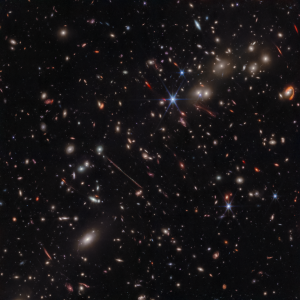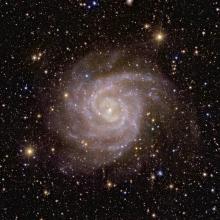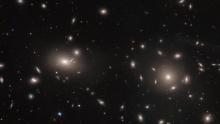Thousands of galaxies crowd this Webb Space Telescope image of a giant galaxy cluster known as El Gordo--"the fat one." It consists of two large clusters that are merging, about seven billion light-years from Earth. The gravity of the visible galaxies and their dark matter, which is detectable only through its gravitational influence, distort the light of more-distant galaxies, creating long arcs. Astronomers use this lensing effect to calculate the amount of dark matter in the cluster. [NASA/ESA/CSA]
You are here
El Gordo
El Gordo – the fat one – might not be the most flattering name for a galaxy cluster. But it’s certainly accurate. El Gordo is the most massive cluster yet seen that’s so far away – more than seven billion light-years.
The cluster is actually two clusters that are ramming together. They contain hundreds of individual galaxies. They total about 2300 times the mass of our own galaxy, the Milky Way. Most of that mass consists of dark matter. It produces no detectable energy, but it reveals its presence through its gravitational pull on the visible matter around it.
Astronomers measure the amount of dark matter by seeing how the cluster distorts the light of background galaxies. They know the mass of the visible parts of the galaxies. They subtract that from the cluster’s gravitational mass to calculate the amount of dark matter.
El Gordo is so far away that we see it as it looked when the universe was a bit less than half its current age – about six-and-a-half billion years after the Big Bang. No other cluster at that distance or beyond is that heavy. So the cluster provides an excellent laboratory for studying galaxies and dark matter in the early universe.
El Gordo is in Phoenix, the firebird. The constellation is so far south that it’s not visible from most of the United States – only Hawaii and southern Texas and Florida. From those locations, the firebird is low in the southern sky at nightfall.
Script by Damond Benningfield
Get Premium Audio
Listen to today's episode of StarDate on the web the same day it airs in high-quality streaming audio without any extra ads or announcements. Choose a $8 one-month pass, or listen every day for a year for just $30.






